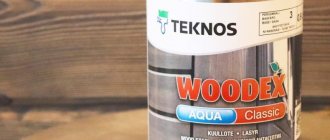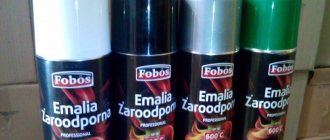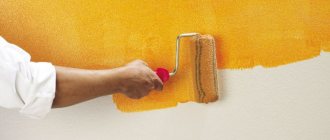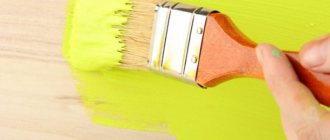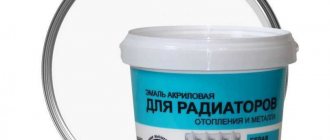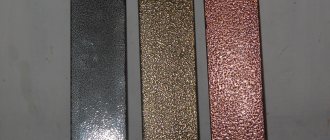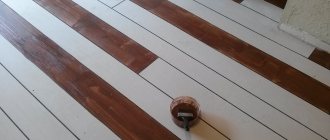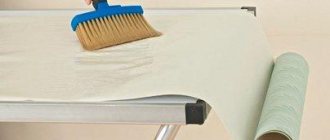Why paint floors
Painting wooden floors is necessary not only to give them an aesthetic appearance, but also to protect the wood.
It is important to know how to choose paint for the floor; for this you need to focus on the following criteria.
- It is necessary to consider the type of wood from which the floors are made.
- Location - for example, there is high humidity in the kitchen or bathroom, this also needs to be taken into account.
- The presence of the old coating and its compatibility with the new coating.
- Lifetime.
- Condition of the floor covering.
How to choose paint for wood
All of the previously mentioned materials are excellent for wooden surfaces. But to select the optimal material, it is necessary to take into account the properties of the surface being processed:
- Wood species.
- High or low cross-country ability.
- Indoor air humidity.
- Possibility of treating wood with protective oil.
- Optimal service life.
You should make your choice responsibly, as the appearance of the wooden floor will depend on it.
Types of floor paint
Floor paints and varnishes are presented in a wide range, all of them are divided into types.
- Oil paint. This material is based on drying oil, which is considered an environmentally friendly material. The disadvantages of this paint include the long drying time, so the demand for it has dropped significantly.
- Acrylic paint. A popular paint and varnish material that has many positive qualities. It dries quickly, has no odor, and is also very resistant to mechanical stress.
- Alkyd enamel. The main disadvantage of this paint is the presence of a strong odor that lingers in the room for a very long time. Experts recommend using this paint for exterior use.
- Polyurethane paint. It is famous for its characteristics such as strength and wear resistance. This type of paint is often used in industrial areas. It has many advantages, but also high cost.
- Varnish for wood. They protect wood well and have high elasticity.
- Oil - wax. This coating preserves the natural texture of the wood and protects it perfectly.
All types of floor paints have their advantages and disadvantages, which should be taken into account when choosing.
Rubber paint
Rubber paint is a new development that has many advantages. It is created on the basis of polymers; after drying, a dense protective layer is formed on the floor, which resembles rubber. This coating turns out to be extremely elastic, cracks do not form on it and no peeling occurs.
Thanks to special pigments, rubber paint does not fade even when exposed to direct sunlight.
Rubber paint has the following advantages:
- Economical consumption;
- Wear resistance;
- Resistant to temperature changes and moisture;
- Excellent corrosion protection;
This is a great paint option for wood floors and is a modern finishing solution.
Wear-resistant paint
When choosing floor paint, many consumers prefer to choose wear-resistant paint materials. This paint is made on the basis of acrylic, it has many positive qualities.
- Hygroscopicity;
- Easy application;
- Resistance to mechanical loads;
- Quick drying;
This is a very durable coating that can be used for highly stressed surfaces. Wear-resistant floor paints are reliable protection of wood from mold and mildew, making them the number one choice.
Painting wooden floors
First of all, you need to cover the walls and trim with masking tape. If you plan to use two different colors, then a dividing line is glued.
Then the material is prepared. The mixture is thoroughly mixed, if necessary, pigments and accelerators are added to it. Then the prepared solution is added to the paint bath. It should be remembered that quick-drying wood paint is covered with a film in a matter of minutes. You need to pour it into the container in small quantities, immediately after that tightly closing the jar.
First, baseboards and internal corners are processed. The floor is partially captured if further work is carried out with a roller.
The mixture should be applied starting from one of the corners opposite the front door. The board is painted along the grain of the wood. The mixture is evenly distributed over the surface until the roller or brush is completely dry. This will avoid the appearance of drops and sagging.
After the first layer has completely dried, the procedure is repeated. The second layer will not only create a more durable coating, but also eliminate the influence of the base background on the paint color.
Features of coloring
In order for a wooden floor to have a presentable appearance, it is necessary to take the staining procedure seriously. First of all, it is necessary to prepare the floor covering, sand and clean it. If this is not done, then paint or varnish will only highlight the imperfections of the floor.
For sanding, it is recommended to use a sanding machine, after which the boards must be wiped with a solvent.
- In order for the color of the floor to be as even as possible, the paint must be applied in two or three layers, each of which must first dry well.
- To prevent the painting process from being delayed, it is best to opt for quick-drying paint, which is the most convenient option.
The order of preparatory work before painting
The quality of painting depends not so much on the chosen material, but on the correct preparation of the base and application of the material.
Depending on the repair conditions, the preparatory work algorithm may be as follows:
- Drawing up a sketch. Choice of color and pattern.
- Perform calculations. Determining the amount of necessary materials, fixtures and tools.
- Purchasing everything needed for repairs.
- Cleaning the floor from old finishes (if this technology is chosen).
- Leveling the surface. Seal large holes and cracks.
- Applying a primer (only on cleaned wood).
- Application of paint and varnish material to the surface.
At the end of the work, it is advisable to wipe the coating with a soapy solution and vinegar to remove any remaining oil from the surface.
What tools will you need?
Before starting work, you need to prepare everything you need so as not to be distracted during the repair process.
The following tools and materials will be required:
- Roller with telescopic handle. Depending on the chosen composition, a foam or fur nozzle is used.
- Brush. You can’t do without it when processing baseboards and internal corners.
- Paint brush with natural bristles. Used for painting bases with a textured surface.
- Putty knife. Necessary for removing old coating, sagging and filling irregularities.
- Paint bath. Needed to load paint regardless of whether a roller or brush is used.
- Masking tape for protecting walls and trim, drawing demarcation lines.
- Solvents for diluting thick liquids, removing splashes from walls, clothing and hands.
- Rubber gloves and assembly glasses.
To apply alkyd compounds, you can use a spray gun.
Treating floors with a primer before painting
If the old paint has become unusable, then there is no point in wasting time and effort on leveling it.
You can remove the old coating in the following ways:
- spatula;
- plane;
- grinding machine;
- blowtorch;
- factory-made remover.
After cleaning, the base must be leveled. The protruding parts are ground down with sandpaper by hand or with a belt machine. Then you need to putty the cracks, holes, chips, cracks and other surface defects. This is done with a wood compound and a spatula. It is advisable to use a solution whose color is the same as the base. After drying, the grout must be sanded and polished. Then the surface is cleaned of crumbs and dust.
The floor to be painted must be treated with a primer to clog the pores in it and strengthen the top layer. This will increase surface adhesion, facilitate application and reduce material consumption. The primer can be applied with a brush or roller. After the first layer has dried, the procedure should be repeated.
Paint manufacturers
There is a rating of popular manufacturers of floor paints, which includes the best options.
- Prestige Premium.
- Sniezka.
- Drylok Latex.
- Tehnofloor Teknos.
- Tikkurila.
The most worthy choice is Tikkuril floor paint, which is produced in Finland. It has been on the market for over a hundred years and is famous for its amazing quality, which significantly sets this paint apart from its competitors.
The company produces not only floor paint, but also paint for other surfaces. The cost of this paint fully justifies its technological performance.
Painting technology
Application of protective compounds
Before applying paints, the floor must be protected from moisture and pests. Usually special liquids, primers and antiseptic impregnations are purchased for this. They are very important and perform special functions:
- Makes the material fireproof
- Bleaching
- Prevents the spread of fungus and insect infestation
- Reduces the consumption of the base coating
- Increases resistance to damage
We advise you to buy such solutions from the same company as the paint for the floor on the open veranda.
Drying time for the protective layer is at least three days.
Applying paint
Pexels
The application of dyes is carried out in several stages. You need to ensure that each layer is very thin. Ideally, the coating should consist of three layers. Floor paint on an open veranda is applied with a roller or a wide brush and done along the boards, not across. Otherwise, the substance will accumulate unsightly between the boards. The sides and hard-to-reach places are treated with a small brush.
Dry the paint for 3-5 days. If the boards are completely new and this is the first coating, then drying can last up to a week.
After you have applied all the layers and dried them thoroughly, the floor should be rinsed with hot water.
Impregnation coating
After the coloring composition has dried, we begin impregnation. Depending on the choice (oil or varnish), the product must be mixed. Read the instructions carefully, as some types of oils require dilution; with varnishes it’s a little easier. Next, use a wide brush to paint each board, paying special attention to the joints and ends.
It takes a day to dry the first layer. After which the application of the composition must be repeated.
Tips for choosing paint
Modern experts do not recommend using oil paint, as it has a strong odor and takes a very long time to dry.
- The most popular option is acrylic paint, which protects wood well and is wear-resistant.
- In order to save money, you can opt for alkyd paint or enamel; they look great and have a long service life.
Polyurethane paints break all records for durability, and rubber paint does not slip and forms a pleasant soft coating.
The best alkyds
Tikkurila Betolux
Urethane-alkyd based composition suitable for wood and concrete floors exposed to moderate chemical and mechanical stress. It is also acceptable to use enamel in warehouses and trade premises, to cover stairs.
The paint adheres well even in conditions of high humidity, which makes it suitable for saunas. It can be applied to surfaces previously painted with epoxy and alkyd compounds. Consumption varies from 9 to 11 sq. m per 1 liter of enamel.
LAKRA PF-266
Enamel for interior finishing of painted and untreated wood floors. The product is based on alkyd varnish. The product is distinguished by good adhesion to the surface, decorative effect, uniformity and smoothness of the applied layer. The paint and varnish material is highly resistant to abrasion.
The paint hardens after 8 hours; final drying will require at least 24 hours. For 11-17 sq. m of area, about 1 kg of composition is consumed. White spirit is suitable for dilution.
Yaroslavl paints for floors and stairs
High strength urethane-alkyd product for wood, metal and concrete. It dries quickly, is resistant to atmospheric influences, mechanical wear and the effects of household chemicals. It can be used to paint floors, staircases and terraces. You can work both indoors and outdoors.
Enamel costs are 1 kg per surface of 10-12 square meters. m. One layer dries up to 8 hours, recoating is possible after 12 hours. Final consolidation occurs one day after completion of the work.
Prestige for the floor
Alkyd enamel with a glossy effect, suitable for application to painted and new wooden stairs and floors located inside industrial, residential and domestic buildings. It has good protection against moisture, abrasion and reaction to disinfectants and washing agents.
The finished coating has elasticity that prevents microfractures of the material, a strong structure and decorative properties. The product is convenient to work with and easy to apply. The drying period takes up to 12 hours, the can is consumed at the rate of 100 to 180 g per 1 sq. m.
Caring for Painted Floors
It is necessary to carry out proper care for the painted coating, which can extend the life of the floor.
- Painted floors must be wiped with a damp cloth at least three times a week. If the surface is heavily soiled, ammonia can be used. Do not use solutions based on soap or abrasive substances such as soda, as they negatively affect the paint. To give your floors a nice shine, you can wipe them with vegetable oil and then rub them with dry paper towels.
- Use a vacuum cleaner to remove dust from crevices and corners. It is necessary to use a soft brush for the vacuum cleaner so as not to damage the floors during the cleaning process.
- Do not use steam cleaners, bleach solutions or hard metal brushes to clean wooden floors.
How to properly prepare a floor for painting
Before painting a wooden floor, you should carefully prepare the surface. You should not ignore this stage, because the quality of the work performed will depend on it. This requires:
- Remove dust and other possible contaminants using detergents.
- Clean the cracks using any sharp tool.
- Degrease the surface.
- Remove all visible and tangible knots, nails and other irregularities from the surface.
Photo of floor paint
Popular acrylic enamels
Chief technologist
Acrylic paint for finishing floors of commercial and residential buildings. It is also used for interior elements that experience increased loads during use, such as furniture, doors and stairs. Work is possible both with previously painted and with clean materials such as wood and concrete.
The composition does not have a strong odor, is environmentally friendly and waterproof, and has a semi-matte texture. Interlayer drying takes about 1 hour, complete hardening occurs after 12. The surface can be subjected to high loads no earlier than after 96 hours. Product consumption – 150-200 g per 1 sq. m taking into account the distribution in two layers.
V33 Renovation Perfection
Semi-matte composition for stairs and floors with water-repellent properties, which does not require preliminary priming of the surface before application. The paint is used for interior work in rooms with standard and high humidity levels, but is not applicable in shower rooms.
Suitable for application are varnished floor coverings, ceramic tiles, marble, wood, granite, laminate. Drying time is 24 hours. A volume of 1 liter is enough for 10-12 square meters. m. area. For application use a roller or brush.
LAKRA enamel
Water-based paint on an acrylic base, characterized by a short drying period and a durable surface. Intended for finishing wooden floor coverings located inside and outside the house, as well as concrete bases indoors. Suitable for painting furniture, doors.
The composition can withstand 5 frosts down to – 35 °C without losing its qualities. Primary drying takes place within an hour, complete hardening takes 8 hours. Product consumption is 100 g per square meter. m.
OLECOLOR
Enamel for interior finishing of concrete and wooden floors, creating a decorative and protective coating on furniture, doors and various wood products. The paint is quick and easy to apply, has no unpleasant odor and dries in a short time. Belongs to class 1 abrasion protection and has good water resistance.
The composition has high-quality adhesion to various surfaces. Costs per 1 sq. m are about 75-95 g. The service life is 3 years. Drying of the enamel lasts 1 day, maximum strength gains occur after 10 days.
